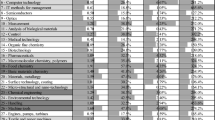Abstract
S-curves analysis allows to study evolution and trends in specific technological fields; its theoretical background establishes that in order to achieve the best results the analysis must be done using an independent variable that shows the effort invested in R&D activities and a dependent variable that shows the cumulative performance in that field. Actually, S-curves are built using time as independent variable because of the constraints associated in the search of investment data. This paper examines the use of patent data applications as a sample of effort; using geothermal field as a case study, it was possible to test the relationship of Patent applications and investment (R-squared, 0.86), in first place, and the construction of S-curves using patent applications count against performance (R-Squared, 0.947). Results show a high correspondence value and potential of using patent counts to direct technological performance studies.



Similar content being viewed by others
References
Ayres, R. U. (1994). Toward a non-linear dynamics of technological progress. Journal of Economic Behavior & Organization, 24, 35–69.
Daim, T., Rueda, G., Martin, H., & Gerdsri, P. (2006). Forecasting emerging technologies: Use of bibliometrics and patent analysis. Technological Forecasting and Social Change, 73(8), 981–1012.
Dubaric, E., Giannoccaro, D., Bengtsson, R., & Ackermann, T. (2011). Patent data as indicators of wind power technology development. World patent information, 33, 144–149.
ESPACENET. (2012). Patent search tool. Available online: worldwide.espacenet.com. Access: October 10, 2012.
Foster, R. (1986). Innovation: The attacker′s advantage. New York: Summit books.
Fu, X. L., & Yang, Q. G. (2009). Exploring the cross-country gap in patenting: A stochastic frontier approach. Research Policy, 38(7), 1203–1213.
Griliches, Z. (1998). Patent statistics as economic indicators: A survey. Book chapter: R&D and productivity: The econometric evidence. Pages: 287–343. ISBN: 0-226-30886-3. Available online: http://www.nber.org/books/gril98-1.
International Energy Agency. Data statistics. Energy Technology R&D 2012 edition (free access). Available online: http://wds.iea.org/wds/ReportFolders/ReportFolders.aspx. Access: April 1, 2013.
Kucharavy, D., & De Guio, R. (2011). Procedia Engineering, 9, 559–572.
Lee, S., Yoon, B., et al. (2009). Business planning based on technological capabilities: Patent analysis for technology-driven roadmapping. Technological Forecasting and Social Change, 76(6), 769–786.
Liu, J., Kuan, C., Cha, S., Chuang, W., Gau, G., & Jeng, J. (2011). Photovoltaic technology development: A perspective from patent grow analysis. Solar energy materials and solar cells. Vol, 95, 30130–33136.
Liu, C., & Wang, J. (2010). Forecasting the development of the biped robot walking technique in Japan through S-curve model analysis. Scientometrics, 82, 21–36.
Nieto, M. (1997). Análisis del rendimiento tecnológico mediante el modelo de la Curva S: fundamentos teóricos y metodología operativa. ESIC Market, 98, 161–192.
Nikula, U., Jurvanen, C., Gotel, O., & Gause, D. (2011). Empirical validation of the classical change curve on a software technology change project. Information and Software Technology, 52, 680–696.
Noruzi, A., & Abdekhoda, M. (2012). Mapping Iranian patents based on international patent classification (IPC), from 1976 to 2011. Scietometrics, 93, 847–856.
OECD. (2000). Compendium of patent statistics. Available online: http://www.Oecd.Org/Dataoecd/5/19/37569377.Pdf. Access: November 13, 2012.
Sawaguchi, M. (2011). Innovation activities based on s-curve analysis and patterns of technical evolution-’’From the standpoint of engineers, what is innovation?’’. Procedia Engineering, 9, 596–610.
Schiling, M., & Esmundo, M. (2009). Technology S-curves in renewable energy alternatives: Analysis and implications for industry and government. Energy Policy, 37, 1767–1781.
Yuan, J., Ma, N., Hu, Z., Shi, F., Yu, Z., & Wu, Y. (2010). Patent activity on water pollution activity in China—A scientometric perspective. Scientometrics, 83, 639–651.
Author information
Authors and Affiliations
Corresponding author
Rights and permissions
About this article
Cite this article
Sepúlveda, J., Paternina, A. & Suarez, A. Patent applications as source for measuring technological performance. Scientometrics 98, 1385–1395 (2014). https://doi.org/10.1007/s11192-013-1050-4
Received:
Published:
Issue Date:
DOI: https://doi.org/10.1007/s11192-013-1050-4




